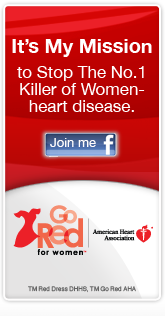Today’s author, Andy Steiner, was my first professional boss. She was editor of the Minnesota Women’s Press when I started there as an intern right out of college. We only worked together a few months, but it was long enough to make an impression — I was then and I am now impressed and inspired by Andy’s work. Though she notes below that we lost touch for many years, I knew she was writing books and national magazine articles (Ms.!) and editing the Utne Reader, among other cool jobs, and she was always ready with an answer to my career questions, even if spaced years apart. And then one day she emailed to catch up and told me about this book. She’s right that I feel inadequate to the term survivor, but I wanted to tell her my story for the same reasons I write this blog and let video cameras into my home and allow my head to appear 14 feet tall on the freeway. Because people — especially women — need to know about heart disease.
When Andy and I worked together at the Minnesota Women’s Press, its mission was “to promote women’s words, ideas, and values in ways that create community . . .” To say my short time there made an impression is something of an understatement. My first job, my first boss, her words, my words are all still working toward that mission today.

Looming Large
by Andy Steiner
The other day, I was driving east on 494 and there she was: Jennifer Thorson, looming larger than life on a humongous billboard promoting Heart Month 2013. It was fitting, really, that the very woman who’d been the focus of my attention for the last few months had suddenly appeared in my windshield like a gigantic (and glamorous, I should add) Godzilla. Jen — and her story — had certainly been looming large in my mind. Why wouldn’t she be on a billboard?
I should explain that I’d been thinking about Jen lately because I am featuring her in a book I am writing, titled How To Survive: The extraordinary resilience of ordinary people. My book, which will be published later this year by Minneapolis-based Think Piece Publishing, features stories of regular folks who’ve faced traumatic life events with strength and courage. These “survivors” explain how they continued to live their lives after facing trauma. Jen’s story, and her subsequent activism, inspired me to feature her in a chapter of my book.
I didn’t always think of Jen as a survivor. I first met her decades ago, back when she was a student at Hamline University and I was editor of the Minnesota Women’s Press. Back then, Jen was editor of her school’s paper, and I was looking for interns. I remember calling Jen at newspaper’s office and suggesting she apply for an internship. She was a great intern, and later took a paying job at the paper. We both grew up, moved on, and lost touch.
Then, a little over a year ago, I picked up a copy of the Women’s Press and read an essay that Jen had written about her heart attack. I hadn’t seen her for years and didn’t know anything about what was going on in her life. I sent Jen an email and met her for coffee, where I told her about my book asked if she’d be willing to be interviewed. I don’t know for sure, but I got the feeling at the time that Jen wasn’t convinced that her personal story — unexpected major heart attack at age 37 — elevated her to the status of “survivor.”
It’s not the first time I’ve had that reaction. A lot of people think that survivors are a rare breed, people who’ve lived through harder challenges than they have with more bravery and grace, the kind of folks who faced a blizzard on Mount Everest or escaped a team of hijackers. Jen, I guessed, just thought her story was too ordinary, too personal, not something that would interest others.
But that’s the whole point of my book. I’m writing about the universal experience of facing tough times, of ordinary people who stare down extraordinary challenges and emerge bruised or altered, perhaps, but still strong. The truth is that hard things happen to everyone. How we deal with those individual challenges is what sets us apart.
Not long after I first met Jen, back when I was in my mid-20s, I was seriously ill and I had to go to an urgent care center. It was one of the lowest points of my then-fairly short life. Sick, tired, scared, and weepy, I felt strangely comforted when a nurse lightly touched my shoulder and said, sweeping her hand in a gesture that seemed to take in everyone there, patients and healthcare providers alike, “Welcome to the ranks of the walking wounded. You might not be able to recognize us at first glance, but we’re everywhere.”
I still clearly remember how the nurse used the words “we” and “us,” deftly including herself — and me — in the ranks. To be included as a “walking wounded” felt jarring, but somehow beautiful. I looked around that room and saw people of every color, age, and size. Some looked obviously sick, some healthy and vigorous. I had felt so alone in my own particular trauma that I couldn’t see the traumas of others. When the busy nurse made her comment and then bustled off to help another patient, I didn’t feel so alone — or, for that matter, so self-obsessed. That altered view of the world is why I eventually decided to write this book.
Jen, and the ordinary/extraordinary life she’s been living since learning about her heart disease, are a perfect example of how any person can choose to face a challenge with grace and courage. I know, because I have spent plenty of time interviewing Jen and her loved ones, that her new post-heart-attack life has had its challenges, but I’m guessing that she might also say that it’s also had its share of rewards.
I’m hoping that my book will emphasize those rewards and illustrate for others how Jen is living her extraordinarily resilient life. Her big, important life story is one that bears repeating, and I feel honored that I get to write it all down.
 Andy Steiner is a St. Paul-based writer and editor. Her book, How To Survive: The Extraordinary Resilience of Ordinary People, will be published in 2013 by Minneapolis-based Think Piece Publishing.
Andy Steiner is a St. Paul-based writer and editor. Her book, How To Survive: The Extraordinary Resilience of Ordinary People, will be published in 2013 by Minneapolis-based Think Piece Publishing.



Recent Comments